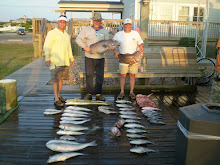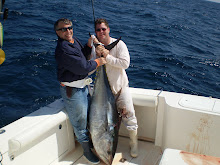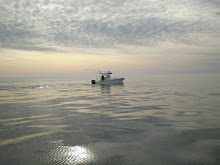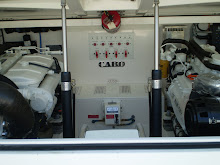 By Jim Field
By Jim FieldWith winter completed, a month ago already--April 25 to be exact--we moved the
Sea Ya Bea back home to Hatteras Village, slip #48 in Teach's Lair Marina. Dan, Jim, and Andrew formed the nucleus of the Crew. Andrew, in turn, was anxious to bring a friend along, and so an invitation was extended to a close running mate, Austin Taylor, and his dad, David. At previous school and sports functions, David and I had exchanged notes on outdoor hobbies, and David expressed an interest in deep sea fishing. In proposing this particular trip, I wrote David an email outlining the game plan: depart Alexandria 4:30 pm Friday after school and work; drive five hours to Manteo and Pirate's Cove Marina; eat along the way; sleep onboard; cast off lines and depart for Hatteras Village at first light Saturday morning; transit and fish heading South; tie up in Teach's around 5:00 pm; clean boat and fish; check into Breakwater Motel at Oden's Dock; clean body with cocktail nearby; go to dinner and eat and drink well; sleep hard; wake up early Sunday morning; breakfast at Sonny's; head North for home; stop off and see Cape Hatteras lighthouse. I cautioned about severe lack of sleep and potential for rough seas. I copied Diane on the email, and she responded by asking why anyone would want to voluntarily do something like this, i.e., a weekend involving long car rides, up before the sun, boating for an entire day, etc. "Is this really something fun to do?" I told her this was fishing. To be honest, I expected the Taylors to politely decline: I've found over the years that there is a big difference between talking about going fishing in theory--as part of friendly conversation over a beer--and actually committing to a trip when presented for real. To my surprise, David and Austin were "in" and excited to go. Fantastic! We had a shared adventure before us.
In high spirits we departed Alexandria and arrived at Pirate's Cove in Manteo about 10:30 pm. Dan arrived 30 minutes later in his truck. David and I had stopped earlier at a grocery store and gotten ice and squid (for bait). We set up the cockpit and stowed equipment, sipping beers, until about midnight, and then hit the bunks, Dan sleeping (snoring) on the carpeted cabin deck.
Long before official sunrise, the men were up and preparing to depart. Andrew and Austin, alternatively, elected to stay in their bunks. We cast off from the slip and navigated the inland waterway channel without incident (not a guaranteed outcome, to be sure). Clearing the last set of red-green ocean channel buoys, we set a course to run South (180 degrees on the compass) to the 280 Rocks, distance 40 miles, where we planned to begin fishing. We encountered a 2-3 foot, 5-7 second swell from the SE, but were able to make about 25 knots SOG. The sky was a mixture of gray overcast, with darker sections where we were headed.
The ocean forecast for the trip had been tricky. According to the report from Diamond Shoals buoy (reproduced below), Friday (our travel day, of course) was going to be benign: wind 10 knots, 2-3 foot seas with waves 11 seconds apart. Pure cake walk. Friday evening, however, wind speed was to increase to 10-15 knots--which is still perfectly fine--but noteworthy in starting a trend towards progressively higher wind speeds across the weekend, culminating in 30 knot winds Sunday evening. With a notch-up of wind speed, seas were also expected to increase, but remain 2-4 feet on Saturday and only increase to 3-5 feet Saturday evening. The takeaway message was that if the weather cooperated, we could expect 10-15 knot winds and 2-4 foot seas--conditions ideal for transiting and fishing. But, if the weather trend developed earlier than forecast, we could end up dealing with 20 knot winds and 5 foot seas, which would prove challenging--not to safety, but bringing fish onboard the boat. Oh yes, and rain and scattered thunderstorms were 30% likely, lending yet another wrinkle to the weather scenario
Diamond Shoals buoy report for FridayAMZ152-154-231930-
S OF OREGON INLET TO CAPE HATTERAS NC OUT 20 NM-
S OF CAPE HATTERAS TO OCRACOKE INLET NC OUT 20 NM
INCLUDING THE MONITOR NATIONAL MARINE SANCTUARY-
351 AM EDT FRI APR 23 2010
TODAY
W WINDS 10 KT...BECOMING VARIABLE 10 KT OR LESS THIS AFTERNOON.
SEAS 2 TO 4 FT DOMINANT PERIOD 11 SECONDS.
TONIGHT
SE WINDS 5 TO 10 KT...BECOMING E 10 TO 15 KT AFTER
MIDNIGHT. SEAS 2 TO 3 FT DOMINANT PERIOD 11 SECONDS. A SLIGHT CHANCE
OF SHOWERS.
SAT
SE WINDS 10 TO 15 KT. SEAS 2 TO 4 FT. A CHANCE OF SHOWERS. A
CHANCE OF TSTMS IN THE AFTERNOON.
SAT NIGHT
S WINDS 15 TO 20 KT. SEAS 3 TO 5 FT. A CHANCE OF
SHOWERS AND TSTMS.
SUN
SW WINDS 20 TO 25 KT...INCREASING TO 25 TO 30 KT IN THE
AFTERNOON. SEAS 6 TO 9 FT. A CHANCE OF SHOWERS AND TSTMS.
As things turned out.....the rougher weather did arrive sooner than expected. Upon reaching our fishing spot, we set up to troll and made a go of it, but were unable to hook up. To be fair, this was due to the vagaries of fishing and water temperature and clarity, not to wind and surface sea state. After an hour on the troll, we came across 3-4 boats bottom fishing near the Rockpile, and so we switched tactics. By this time, the wind was a strong 20 knots and we were definitely seeing rolling waves of 8-10 feet, although a friendly 7-10 seconds apart. We lowered our weighted baits to the bottom in about 250 feet of water, and found that we were drifting at a 2 knot pace--so not too bad. Across the next hour, we were able to hook up to some nice fish--David in particular catching 2 very nice vermilion snappers. By around 3:30 the other boats had departed, maybe due to the weather. We brought a few more fish onboard. Had we worked the area for 3 or 4 hours, we likely would have been able to bring in 10-15 fish, although our timing today (and Andrew feeling green) didn't align with spending a lot of time with bait on the bottom.
We picked up at 4:00 pm and set course for Hatteras Inlet, about 25 miles to the North. Benefiting from a following sea, the ride home was comfortable. We navigated the channel and inland waterway without incident (an easy run compared to Oregon Inlet) and pulled into Teach's Lair Marina, returning after nearly six months away. All in all, our trip had been successful, in that we had accomplished "Mission A," which was to move the boat back to Hatteras Village. On the fishing side, "Mission B," things didn't go our way, and so this was disappointing. (Note: we'll get'em the next time around!) Yet no one got hurt, nothing was damaged, no mechanical failures, and we had a day at sea in all its glorious elements--with family and friends--and this kind of day is always something special to cherish and remember. So net-net: a great day to be alive and blessed to have such adventures.

With the
Sea Ya Bea secured in its slip--all cleaned up and ready to go again--we shifted gears to the next set of priorities focused around food, beverage, and comfort. Unfortunately, Dan had to head home for Sunday family commitments and departed in his truck (WaWa Bob and his Crew drove our two vehicles down from Pirate's Cove the previous evening; thanks Bob!). The four of us checked into the Breakwater Inn and showered and rested before dinner at 6:30. We decided to dine at Teach's and had a great meal--three of us had grilled or blackened mahi-mahi, with huge portions served. Austin went with the snow crab legs. As an appetizer, we shared two dozen local shrimp prepared in Old Bay seasoning. While we were peeling and devouring, David told us a funny story from college days when he entered a contest and ate 22 dozen shrimp (he didn't mention if he won). After a day of work at sea, and with a pitcher of beer at hand, I think I could get at least half way to his mark. With our stomachs full (we had dessert too), we headed back to the Breakwater. I believe we said goodnight around 9:00 pm. I was fast asleep 10 minutes later.
The next morning we met at 6:30 and walked across the street to Sonny's for a big breakfast of eggs and meat. Then into the car for a 10 mile trip North to the Cape Hatteras lighthouse. We were almost alone and directed straight to the lighthouse for immediate access. About 270 steps to the top, where we found the wind blowing about 40 knots, just below the point where they would close down for safety reasons. The view was magnificent. Five hours later were were home once again--back in civilization.
Thanks to David and Austin for coming along--Andrew and I had a great time with you guys. Hope you'll come down again--this time to do a number on our watery friends!
The Taylors--David and Austin David bringing in one of his snappers
David bringing in one of his snappers The boys--"Hey, you fish want to mess with us?"
The boys--"Hey, you fish want to mess with us?" On top of the world (Hatteras version)
On top of the world (Hatteras version) Leaning into the wind, Andrew thinking of Fabio's goose encounter
Leaning into the wind, Andrew thinking of Fabio's goose encounter Looking SSW toward Diamond Shoals
Looking SSW toward Diamond Shoals 














































